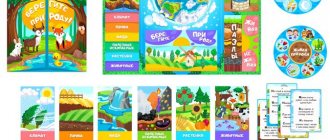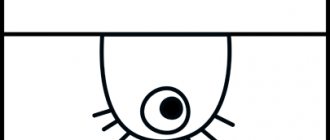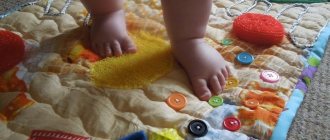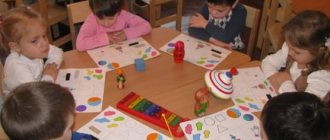Lapbook as an innovative approach to working with children of senior preschool age
Olya Kolyadina
Lapbook as an innovative approach to working with children of senior preschool age
In order to meet modern requirements, teachers of preschool educational organizations need to constantly study, engage in self-education, and improve their level of professional competence. Thus, it is important to learn to adequately respond to ongoing changes in the field of education, competently and efficiently organize educational activities with students, effectively build partnerships with parents to solve educational problems, independently select the content of education and adapt it taking into account the age and individual characteristics of children of a particular group , focusing on the requirements of the Federal State for preschool education .
In connection with the implementation of the Federal State Educational Standard for Education, modern teachers are looking for new approaches , ideas, and teaching methods in order to meet modern requirements for the education and upbringing of preschoolers . One of such teaching aids for today's preschoolers is a lapbook or, in other words, a thematic or interactive folder.
We teachers are faced with the task of finding new non-standard forms of interaction with students. Traditional education is being replaced by productive learning, which is aimed at developing creative abilities and developing interest in creative activities in preschoolers .
One of the possibilities of modern education, which I began to study and apply in my work , is a new form of working with children - “ lapbook ”
.
The relevance of this topic is that a lapbook is an excellent way to consolidate and repeat materials from a project or thematic week.
It can be assumed that increasing : systematic use , free access to lapbooks for children , and the formation of a sustainable interest in preschoolers to create and use laptops .
The role and significance of the lapbook as an innovative approach in working with children of senior preschool age
Lapbook – literally translated from English means “knee book”
(lap – knees, book – book). This is a small homemade folder, a folding book with a lot of different parts, pockets of various shapes, mini-books, accordion books, envelopes that the child can take out, rearrange, fold at will. A child can conveniently place this book on his lap and look through all its contents at one time. But, despite its apparent simplicity, it contains all the necessary
Lapbook technology and its application in the work of a preschool teacher.
Transcript
1 Lapbook technology and its application in the work of a preschool teacher. Modern requirements imposed by the state on the quality of educational activities in kindergarten imply that the teacher must constantly engage in self-education, improve his level of professional competence and master the necessary educational technologies. In connection with the implementation of the Federal State Educational Standard for preschool education, every teacher is looking for new approaches, ideas, forms and methods in their teaching activities that would be interesting to preschoolers and would be appropriate to their age, and would most effectively solve pedagogical, educational and educational problems. We are in a constant search for new technologies and, often, we are faced with a situation, as the saying goes, “Everything new is well forgotten old.” But the Lapbook technology is also a forgotten old thing. I decided to adopt it and apply it in my work. And I was not mistaken in my choice. As practice has shown, this decision gave my work a certain zest. Children accepted the innovation with pleasure, because “Lapbook” is a technology that allows adults to express themselves in limitless imagination, to reveal their creative abilities, and for children it makes the learning process interesting and exciting, allowing them to answer a specific question of interest in one lapbook, through different activities. This is the same fascinating book, only made with your own hands. Lapbook is a relatively new tool from America and is one of the varieties of the project method. Tatyana Aleksandrovna Pirozhenko adapted it to our mentality. She developed this technology for activities with her child and suggested using it in research work with children. Literally translated from English, lapbook means “lap book,” or, as it is also called, a thematic folder or collection of small books with pockets and windows that make it possible to place information in the form of drawings, small texts, diagrams and graphs in any form and on any topic. This is a book that the teacher collects, glues its individual parts into a single whole, and creatively designs using all kinds of colors and shapes. Most often, the basis for a lapbook is hard paper or cardboard, the main thing is that the lapbook is sized to fit on your lap. Typically, this is an A4 folder when folded and A3 when opened. Thus, I concluded that a lapbook is a collective image of a poster, book and handouts, which is aimed at developing creative potential within a given topic, expanding not only one’s horizons, but also developing skills and abilities. Lapbooks help you quickly and effectively learn new information and consolidate what you have learned in an entertaining and playful way. These thematic manuals have a bright design, a clear structure and are ideally developed
2 specifically for a specific child with his level of knowledge. The recommended age for lapbook lessons is 5 years and above. I use it to work with older and pre-school children. And children 7-8 years old can already invent and make their own lapbooks completely independently. Lapbooks can be made either by the teacher himself or together with the child. The ideal option is to make a thematic folder together with the child, then he remembers the information in the process of creating a lapbook. While working with thematic material, the child conducts observations, completes tasks, studies and consolidates information. Subsequently, having a ready-made thematic folder at hand, the child can refresh his knowledge on a particular topic. The size of the finished lapbook, as I already said, is standard around the world: A4 folder when folded and A3 when open. But I made both standard lapbook forms and more voluminous ones in A3 format. The A4 size is ideal so that a child can independently work with a lapbook: hold it in his hands, write and complete tasks in it, and after class put the folder on the shelf. After studying the literature on this topic, I identified several types of thematic folders. Depending on the purpose, they can be educational, playful, congratulatory, festive, autobiographical (a folder-report about some important event in the child’s life: travel, going to the circus, vacation leisure, etc. Depending on the form, laptops come in in the form of a standard book with two spreads, a folder with 3-5 spreads, an accordion book, a figured folder. The material on the laptop is designed as standard pockets; regular and figured envelopes; accordion pockets; book pockets; windows and doors; rotating parts; protruding details; cards; tags; arrows; puzzles; blank sheets for notes, etc. Using a lapbook in working with children is of great importance:
3 1). It helps the child organize information on the topic being studied at will and better understand and remember the material (especially if your child is visual). Adult visual learners will also enjoy this form of learning. 2). This is a great way to review what you've learned. At any convenient time, the child simply opens the laptop and happily repeats what he has learned, looking at the book he made with his own hands. 3). The child will learn to independently collect and organize information; good preparation for writing essays and term papers. 4). The laptop is well suited for classes in groups where children of different ages study at the same time. You can choose tasks that everyone can do (for kids, pockets with cards or animal figures, for example, and for older children, tasks that require the ability to write, etc.) and make such a collective book. 5). Creating a lapbook is one of the types of joint activities between adults and children, and also a form of presenting the results of a project or thematic week. To make a lapbook with your own hands, you need the following materials: cardboard base (cardboard folder, sheet of thick A3 paper, sheets of fiberboard or chipboard); paper (white, colored, scrapbooking paper with various colors and textures); printer and/or pens, pencils, markers, paints; regular and curly scissors; glue, tape, double-sided tape; stapler; decorative elements as needed (buttons, sequins, brads, pendants, paper clips, dried leaves, stickers, themed pictures cut out from magazines, etc.), in other words, everything that is in the house. Ready-made pocket templates for laptops that can be downloaded for free are the best option for beginners. However, you can try to do something of your own, original. I start working on creating a laptop by choosing a topic. The theme of the lapbook can be anything: interesting events taking place in the garden; holidays; hobbies of the teacher, children; topics of the week; literary works; cartoon characters, etc. Topics can be both general and specific. For example, you can make a general lapbook on the topic “Musical Instruments.” Or you can take a specific instrument and give detailed information about it in a lapbook. If you are making a lapbook for preschoolers, then the topics and materials for them should be elementary. In addition, if you are making a lapbook not for a group, but for one child, do not forget to focus on it: what topics need to be studied or reinforced, how advanced the child is in a particular topic. Consult with your child on what topic he would like to select material and make a folder on. These are the lapbooks I made for children: “Musical Chest”, “Russian Folk Art”.
4 After we have chosen a topic, we need to take paper and pen and write a plan. After all, a lapbook is not just a book with pictures. Therefore, you need to think about what it should include in order to fully cover the topic. And for this you need a plan of what you want to tell in this folder. Now we need to figure out how each of the points of the plan will be presented in the lapbook. That is, draw a layout. There are no limits to imagination here: presentation can take any form. From the simplest to games and educational tasks. And place all this on different elements: in pockets, notebooks, mini-books, accordion books, rotating circles, envelopes of different shapes, etc.
5 There are three main options for creating a folder: basic, basic with the addition of 1-2 extensions, and double basic. The production of such bases is shown in detail in the pictures: Next, draw several approximate layouts on a simple sheet or in Word (Paint or a design program), select the best option for placing the necessary information. Think about what your pockets (subtopics) will look like and how the information will be organized in them. Now you can start making a laptop. At this stage, the child can join in the activity. Study according to the thematic folder gradually: one lesson, one task. In conclusion, I would like to say that the Lapbook technology is very simple and effective to use, and most importantly, it is very interesting for children. I think that the Lapbook technology will successfully take root in any kindergarten. After all, it allows us to use innovative methods and forms of work towards the implementation of the Federal State Educational Standard for Education. List of used literature: 1. Lapbook, as the newest way to systematize knowledge. [Electronic resource] / Access mode: (date of access) 2. Lapbook, as part of a subject-spatial developmental environment in kindergarten. [Electronic resource] / Access mode: (date of access) 3. Consultation for teachers: “What is a lapbook?” [Electronic resource] / Access mode: appeals)
6
Lapbook as a learning tool in the context of the Federal State Educational Standard
This article talks about the use of lapbook technology in English lessons. Based on his experience, the author of the article shows the advantages of this method over others within the framework of the implementation of the new federal state educational standard of the second generation, without forgetting the minor disadvantages of this work.
Key words : lapbook, Federal State Educational Standards, creativity, creativity, individual, pair and group work.
In the context of the implementation of the new federal state educational standard of the second generation (FSES), the teacher has to look for new teaching tools that meet new requirements and learning goals.
An important aspect of modern Russian education is “teaching oneself to learn.” The teacher is faced with the task of teaching the student to set goals and objectives, find ways to solve them, and most importantly, find the necessary information to solve the question posed among a huge variety of sources of information. We all know that we remember better what is interesting to us, what was emotionally charged. How to make sure that the material covered remains in the student’s memory, so that he can learn to use the knowledge that he received in lessons on a certain topic, so that he wants to independently expand his horizons on this issue.
One of the ways to achieve this goal of education at this stage of the development of society, I find, is to use the technique of creating a lapbook in English lessons, which is actively used by American teachers and parents who teach their children at home.
First, let's figure out what the concept of “lapbook” means:
A laptop is a portfolio or a collection of small books with pockets and windows that make it possible to place information in the form of drawings, small texts, diagrams and graphs in any form and on any topic. This is a book that the student assembles himself, glues its individual parts into a single whole, and creatively designs it using all kinds of colors and shapes. Most often, the basis for a lapbook is hard paper or cardboard, the main thing is that the lapbook is sized to fit on the student’s lap. [1]
Thus, we can say that a lapbook is a collective image of a poster, book and handouts, which is aimed at developing the student’s creative potential, which teaches him to think and act creatively within a given topic, expanding not only his horizons, but also developing skills and abilities necessary to overcome difficulties and solve the problem.
One of the advantages of this work is the fact that the work on creating a lapbook can be individual, paired or group. Let's look at each of them separately:
Working individually, one student searches, collects information and designs his work independently, relying only on himself and his own strengths. This type of work is necessary if there are students in a group or class who find it difficult to find contact with other classmates, if they are shy and unsociable. It helps such students discover themselves and their potential in front of the teacher and peers.
On the other hand, when working in pairs, students have to share responsibility among themselves. They learn to divide the task into micro-topics and work on their topic individually or do all the work together.
From the point of view of a child’s socialization in society, an important form of work is interaction in a small group, when 3–5 students work on one laptop. Here, on the one hand, everyone must understand their importance, and on the other hand, it should not be allowed that someone is left without a specific task, thinking that someone else will do all the work for him. In a group, schoolchildren learn to build their working relationships not on personal likes and dislikes for each other, but on the desire to do the job as well as possible, especially since the work on creating a lapbook (from its design to its implementation) is labor-intensive both in time and by content.
Work on a lapbook is quite diverse, in addition, the role of the teacher in such work is not to be a source of information, but quite the contrary, the teacher is the factor that pushes students to make discoveries, albeit insignificant at first glance. The teacher is an outside observer who only if necessary intervenes in the process of creating a lapbook and helps with advice when necessary.
Each lapbook is unique, as is its creator, there is no right or wrong method for creating it, because it all depends on how the student perceives a given topic, what means he uses to achieve his goals. [1] Anything is suitable for working on a laptop: colored paper; both cut out and self-drawn pictures; handwritten or printed texts, graphs and diagrams.
Another benefit of a lapbook is the fact that a lapbook is an amazing handmade educational tool. The lapbook itself is very interactive, from the process of its creation to the finished result. And each component of the lapbook that a student works on gives him the opportunity to focus his attention on a specific aspect of a larger topic. [2]
In addition to educational advantages, a lapbook can be perceived by students as a “treasure” to which it is interesting to return, leaf through and revise information, remembering it and accumulating it in their memory. Working, it would seem, on the same topic, children from different pairs and groups very often find solutions to the problems posed to them in different ways - this is surprising, but it is precisely at such moments that the teacher realizes that he is standing on one of the steps of the ladder leading to The main goal of modern education is to teach oneself to learn.
Therefore, when the created “treasure” is shown to classmates, spontaneous discussions and debates occur, which contribute to improving the assimilation of information. If we are talking about the subject “English,” then students develop not only their passive vocabulary when searching for information, but also their active one, because in defending their point of view, they use the material that they found and displayed in a laptop.
It should be noted that while working on one laptop, students often discover topics for their next research. After all, the more often children are faced with the need to learn something new, the more often the unexplored and incomprehensible attracts their attention.
As mentioned above, a lapbook is a specific aspect of a more global topic, therefore, with the correct structure of the work, a teacher, during the period of teaching his subject, can create with a class or group a whole series of lapbooks on one topic, which will more fully reflect the problems associated with this topic. For example, already at the initial stage of training, sections related to food appear. Thus, you can create lapbooks of different content and design that will tell about different aspects of nutrition and everything connected with it. Key questions may include “In a cafe”, “Cuisines of the world”, “Diet”, “Vegetarianism” and much more.
The content and development of these questions and topics will depend on the students, on how they see the problem and on how they want to solve it. As a result, by the end of the training, each student will have his own portfolio, which is interesting to work with, which is easy to use, and most importantly, it will contain the necessary information on various problems of the reality around us.
The fact that solving a problem and filling a lapbook with information depends on the student suggests that when creating a lapbook, individual and differentiated approaches to learning are provided. Evaluating each work also requires an individual approach to each student, since for a student with average academic performance, it is sometimes simply impossible to individually create a work of this order (research, with conclusions, with cause-and-effect relationships). However, while working on a lapbook, he can prove himself and surpass his classmate, whose academic performance is an order of magnitude higher.
It should be noted that the use of lapbooks in the classroom and in extracurricular activities is not possible in every type of educational session for a number of reasons. This teaching method and technique is suitable for a consolidation lesson or a generalization and repetition lesson, when students have a certain degree of knowledge on a given topic, but when creating a lapbook, they have to detail information on the central topic of the lapbook, take a creative approach to the design and explanation of both what has already been studied and and new material.
One of the disadvantages of this work is the time required to create a laptop. One lesson or an outside lesson will not be enough, especially considering the fact that before creating the final product, you need to carefully consider its structure and find the necessary information.
Most of the work (planning and searching for information) can be done at home, but in consultation with the teacher. The final creation of a lapbook must be carried out as part of a lesson, so that the work of each group member or student individually can be seen, so that classmates have the opportunity to share their discoveries with each other.
Also, the teacher, as a senior mentor and assistant, requires additional preparation for the upcoming lesson, because the students will have questions, they will have information that he may not know and you need to be prepared for this, you need to have a correct attitude to the situation when the student knows something that the teacher does not know. In this situation, the teacher must clearly remember and explain to his students that the teacher, within the framework of modern education, is primarily not a source of knowledge, but an experienced guide to the search, perception and assimilation of knowledge.
To summarize, it should be noted that, despite the minor disadvantages that working on a laptop has, its advantages are undeniable. Creating a lapbook solves a number of problems of modern education, giving students not only knowledge of the subject, but also teaching them to look at a problem comprehensively, pose problems and solve them, and take a creative approach to organizing and selecting information.
In the context of modernization of education, a teacher needs to look for new teaching methods and technologies that would help him teach and educate the personality that a new modern society needs - a personality who can think outside the box, propose and implement various ideas. By using the technique of creating a lapbook in your work, you will have the opportunity to prepare just such a person for a new life in new conditions.
A laptop is not just a method that helps consolidate and practice acquired knowledge in the classroom, it is a flight of fancy that can give unpredictable results, it is research that, once started, will continue throughout life, because if you sow the “seed” of discovery and research in a child, it will grow and increase. The teacher’s task is only to give students confidence in their abilities and properly motivate them to open new horizons.
Literature:
1. https://lapbooking.wordpress.com/lapbook/
2. https://www.rosettastone.com/homeschool/articles/what-is-lapbooking






